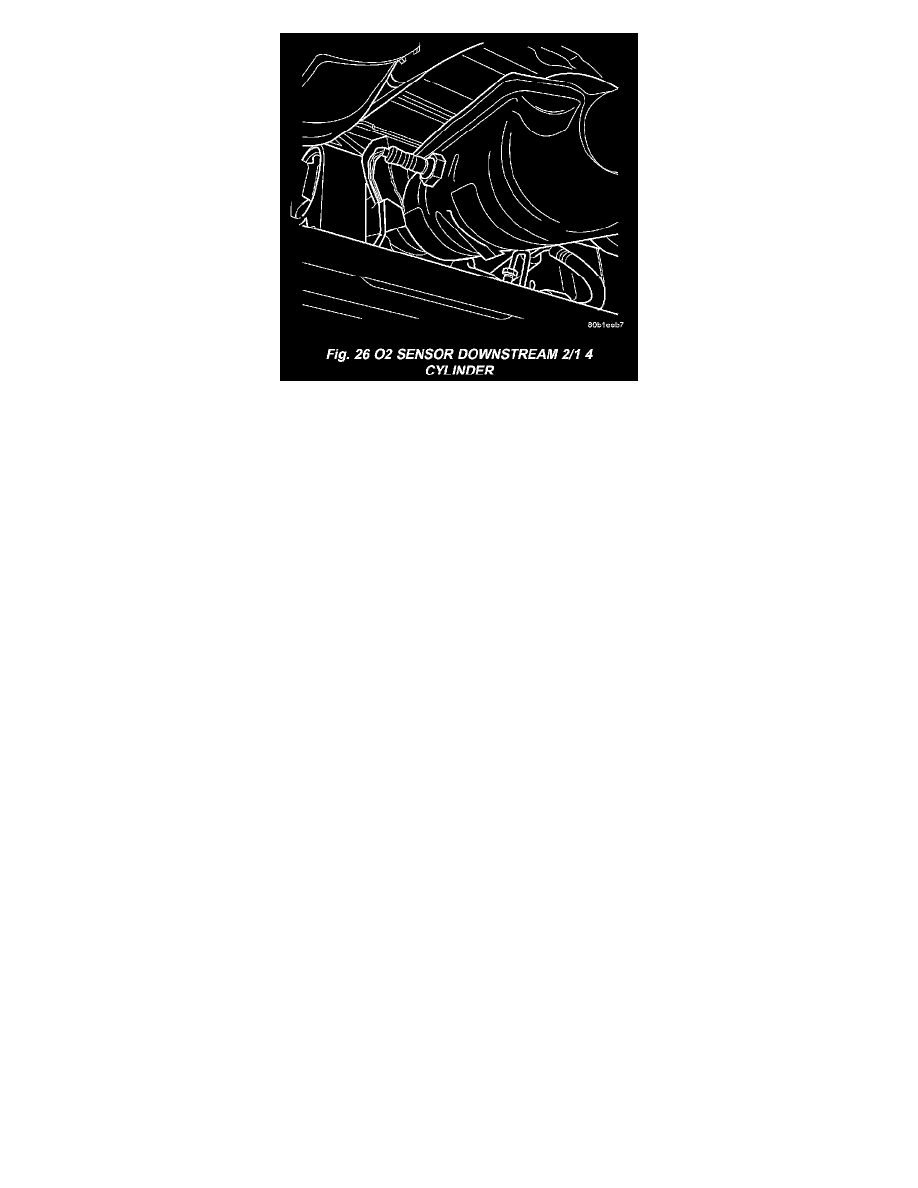Sebring LXI Sedan V6-27L VIN R (2002) Oxygen Sensor Application and ID

Fig.26 O2 Sensor Downstream 2/1 4 Cylinder
The downstream heated oxygen sensor threads into the outlet pipe at the rear of the catalytic convertor.
A single sensor ground is used for all O(2) sensors (2 senors on 4 cyl. vehicles and 4 sensors on 6 cyl. vehicles).
As vehicles accumulate mileage, the catalytic convertor deteriorates. The deterioration results in a less efficient catalyst. To monitor catalytic convertor
deterioration, the fuel injection system uses two heated oxygen sensors. One sensor upstream of the catalytic convertor, one downstream of the convertor.
The PCM compares the reading from the sensors to calculate the catalytic convertor oxygen storage capacity and converter efficiency. Also, the PCM
uses the upstream heated oxygen sensor input when adjusting injector pulse width.
When the catalytic converter efficiency drops below emission standards, the PCM stores a diagnostic trouble code and illuminates the Malfunction
Indicator Lamp (MIL).
The O(2)S produce voltages from 0 to 1 volt, depending upon the oxygen content of the exhaust gas in the exhaust manifold. When a large amount of
oxygen is present (caused by a lean air/fuel mixture, can be caused by misfire and exhaust leaks), the sensors produces a low voltage. When there is a
lesser amount of oxygen present (caused by a rich air/fuel mixture, can be caused by internal engine problems) it produces a higher voltage. By
monitoring the oxygen content and converting it to electrical voltage, the sensors act as a rich-lean switch.
The oxygen sensors are equipped with a heating element that keeps the sensors at proper operating temperature during all operating modes. Maintaining
correct sensor temperature at all times allows the system to enter into closed loop operation sooner.
Also, it allows the system to remain in closed loop operation during periods of extended idle.
In Closed Loop operation the PCM monitors the O(2)S input (along with other inputs) and adjusts the injector pulse width accordingly. During Open
Loop operation the PCM ignores the O(2) sensor input. The PCM adjusts injector pulse width based on preprogrammed (fixed) values and inputs from
other sensors.
The Automatic Shutdown (ASD) relay supplies battery voltage to both the upstream and downstream heated oxygen sensors. The oxygen sensors are
equipped with a heating element. The heating elements reduce the time required for the sensors to reach operating temperature. The PCM uses pulse
width modulation to control the ground side of the heater to regulate the temperature on 4 cyl. upstream O(2) heater only. All other 4 cyl. and 6 cyl. O(2)
heaters do not use pulse width modulation.
Upstream Oxygen Sensor
The input from the upstream heated oxygen sensor tells the PCM the oxygen content of the exhaust gas. Based on this input, the PCM fine tunes the
air-fuel ratio by adjusting injector pulse width.
The sensor input switches from 0 to 1 volt, depending upon the oxygen content of the exhaust gas in the exhaust manifold. When a large amount of
oxygen is present (caused by a lean air-fuel mixture), the sensor produces voltage as low as 0.1 volt. When there is a lesser amount of oxygen present
(rich air-fuel mixture) the sensor produces a voltage as high as 1.0 volt. By monitoring the oxygen content and converting it to electrical voltage, the
sensor acts as a rich-lean switch.
The heating element in the sensor provides heat to the sensor ceramic element. Heating the sensor allows the system to enter into closed loop
operation sooner. Also, it allows the system to remain in closed loop operation during periods of extended idle.
